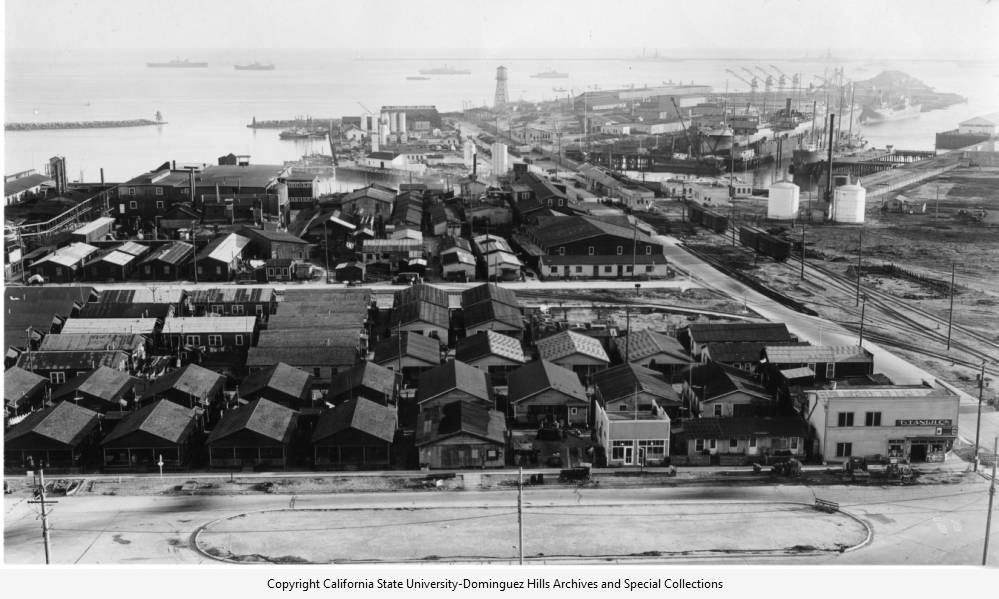On a cloudy morning adjacent to a monument honoring the Japanese Fishing Village in San Pedro — which was once home to 3,000 first- and second-generation Japanese Americans before many were taken to internment camps during World War II — elected officials called Friday on the federal government to end its use of the land as a staging area for immigration enforcement.
Harbor-area leaders such as Los Angeles County Supervisor Janice Hahn, L.A. City Councilmember Tim McOsker, and Assemblymembers Mike Gipson and Al Muratsuchi joined community organizers to highlight how a portion of federally owned land on the island has been used for U.S. Immigration Customs and Enforcement activity. The land houses a federal prison and a U.S. Coast Guard base.

“…There’s a Constitution in the United States of America,” McOsker said. “The Constitution needs to hold, and what we need is an end to these ICE raids that are in violation of constitutional principles.
“We’re making a political demand, a community demand that is coming from the people and coming from elected officials, that we do not want this island — that’s part of our community, that is part of our livelihood, that’s been part of our history — to be complicit in these unconstitutional raids,” he added.
He urged ICE to “get off this island” and to “get out of this community.”
Federal immigration enforcement operations began in Los Angeles June 6 and have spread across the county.
In response to ongoing raids, several cities in the region and the county have announced they would join a proposed class-action lawsuit filed by the American Civil Liberties Union against the federal government on behalf of people who allege they were unlawfully stopped or detained by federal agents.
The lawsuit alleges that federal agencies, including ICE and U.S. Customs and Border Protection, have engaged in unconstitutional and unlawful immigration enforcement raids by targeting Angelenos based on their perceived race and ethnicity and also denying detainees constitutionally mandated due process.
White House officials have previously defended ICE activity in Southern California.
“The brave men and women of ICE are under siege by deranged Democrats — but undeterred in their mission,” the White House said in a statement. “Every day, these heroes put their own lives on the line to get the worst of the worst — criminal illegal immigrant killers, rapists, gangbangers, and other violent criminals — off our streets and out of our neighborhoods.”
The Department of Homeland Security has also denied allegations that such enforcement has been discriminatory.
“Claims that individuals have been ‘targeted’ by law enforcement because of their skin color are disgusting and categorically FALSE. DHS enforcement operations are highly targeted, and officers do their due diligence,” according to DHS.
On Friday, Hahn again insisted that ICE raids over the last weeks have been conducted by groups of agents who are “masked, always armed, (and) pull up to everyday places in everyday neighborhoods.” These agents target and detain “everyday working people,” she added.
“It is a sad, tragic irony that ICE and CBP have chosen this spot as a launching pad for those illegal raids and sweeps that have terrorized communities across L.A. County,” Hahn said.
Starting in 1906, a Japanese American fishing community flourished on Terminal Island in an area known as East San Pedro. Residents worked in the fishing industry and because the island was somewhat separated from the mainland they also developed their own culture and even their own dialect.
The village had a Fisherman’s Hall, where Japanese martial arts were taught, a Shinto Shrine, stores and billiard parlors.
After the Japanese military attacked Pearl Harbor, U.S. President Franklin D. Roosevelt signed Executive Order 9066 on Feb. 19, 1942, which sent 120,00 Japanese Americans to internment camps. Approximately 62% were second and third generation Japanese Americans, and the remaining 38% were Japanese migrants.
Terminal Island residents were the first Japanese Americans on the West Coast to be forcibly removed from their homes, according to reports at the time. The village was later bulldozed and destroyed.
“…I stand here for those hard-working immigrants who are today — just like the Japanese Americans were 80 years ago — being scapegoated and wrongfully accused of being a threat to our communities,” Muratsuchi said.
He echoed his colleagues’ call for ICE to leave and to stop their enforcement operations in the region.
Maya Suzuki Daniels — whose grandfather and family were impacted by the events of World War II — is a member of San Pedro Neighbors for Peace and Justice and said she felt compelled to speak on the issue.
“My grandfather taught me the values of peace, justice, equality and compassion,” she said. “These are the values that guide me today, and that I see reflected in my neighbors here in San Pedro.”
Her group, with support from Union del Barrio, launched the Harbor Area Peace Patrols in June, which inform residents of their rights and monitor ICE activity.
“We’ve documented license plate swapping, faces being covered with balaclavas in the heat of the summer and other efforts to avoid accountability,” Daniels said. “If residents must follow traffic laws, why are these armed agents allowed to break them with impunity?”
Originally Published:















